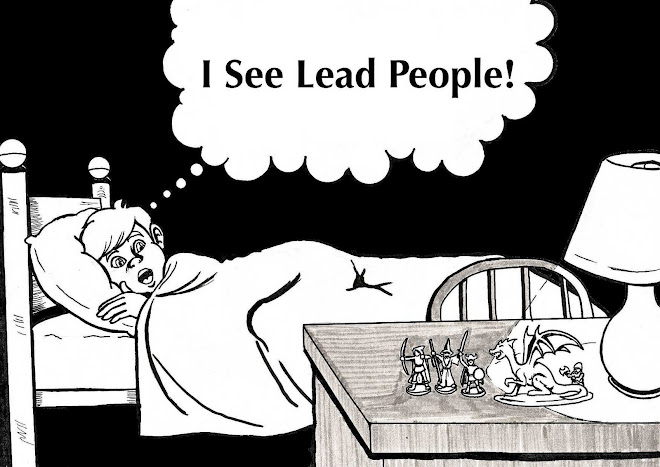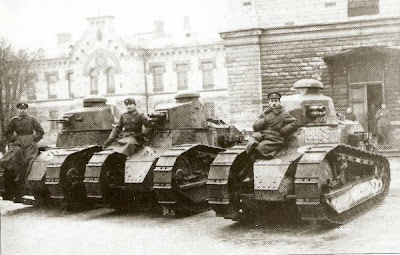Greetings from the landlocked, modest nation of Alcovia. Small in size but packed with people willing (or not so) to give their bodies, lives, and souls for the greater good of their beloved Prince Ullo. Alcovia is known for its brooding citizens, its rabble-rousing poets and the singing horsemen of it's eastern steppes known as the Kuzaks.
I am basing Alcovia after no particular nation but a bit of a hodgepodge of this and that, cobbled together for the feel I want. There will be outdated cavalry, rattletrap armor, even a few planes of I'm lucky. I am still trying to figure out a specific concept for uniforms, though I am leaning toward Romanian for infantry and late 19th/early 20th century Russian for cavalry. Kuzaks will be directly based on Cossacks. The way I see it, Alcovia sits landlocked in Eastern Europe, bordering my mountainous other imag-nation of Elistonia on the west and the vaguely Ottoman imagi-nation of my friend, Iqenistan.
I'll be playing in 15mm to begin with, shifting figs originally pruchased for Chinese Warlord forces into service for these new imagi-nations. I have compiled here the first few posts made to the Interbellum blog and will in the future be posting here as well as there.
THE BREAD RIOT
Right: Artist's rendition of peasants storming a bakery during the Bread Riots.
In 1916, Alcovian common folk in the cities and townships rose up in angry protest against the discovered practice of mixing flower with sawdust and other fillers such as ground chaff and even chalk. This recent practice had been the handywork of bakers who themselves had been victimized by corrupt government grain suppliers who demanded steep kickbacks for the grain they provided.
After three months of on and off again protests and riots, government officials were forced to take action and rooted out at least a dozen corrupt officers from the Department of Agricultural Management. The DAM officers were later found to have amassed a considerable sum of money which, due to the illicit manner in which it was collected, had been shielded from taxation. This elevated their crimes to that of a crime against the state and they were summarily tried and hanged for their "treason".
In the following months the government dispatched bread trucks throughout the country delivery complimentary loaves of bread to townships and within the major cities. Civil order was restored but only after hundreds were killed in the unrest. The Bread Riots, as these events became known, marked a major change in government policies concerning the control of national resources. It should also be noted that rural Alcovia was relatively untouched by these events as local access to quality grain and other agricultural goods left them uneffected by the corruption of the DAM officers.
EARLY ARMOR IN ALCOVIA
The late Alcovian King Ilya Chubacka (1847-1920) and his heirs Ilya II, Ukko and Ullo were known for their fondness for armored vehicles. Ever since Ilya I saw their birth in Great War it had become his dream to one day hear the rumble and rattle of armored might crawling across Alcovia towards her enemies. Unfortunately, financial strife and a low technological base hampered Ilya's dreams beyond a few surplus German tanks, but it was a dream that burned on in his sons Ukko and Ullo.
In 1922, Prince Ukko, working with a conglomerate of Alcovian and Elistonian businessmen and a number of foreign investors, gambled on an enterprise to acquire several copies of foreign tanks for study by Alcovian engineers. The intent was to determine what designs were within the realm of possibility for the small nation both economically and technologically. If designs could be found that were within Alcovia's means, Ukku intended to begin production, either licensed or illegally, for the purposes of both national defense and export.
After considering several designs, Ukko's agents settled upon the now quite common FT-17 as a standard tank for use by the Alcovian military. The FT-17 was a widely used tank and Ukko figured that it would be nearly impossible for Alcovia to be cut off from supplies of parts and new vehicles until it was able to produce on its own. FT-17s were imported from a number of sources including France and Poland and were designated the TA22 for Tankovya Alcovia, Model 1922. In total, 35 of these tanks were initially imported.
By 1924, Alcovia had two factories manufacturing TA22s in both their original and the new TA22/24 which was a new version with more horsepower. In total, 54 TA22s and 32 TA22/24 tanks were built before the Royal Armories developed newer vehicles to phase out the FT-17 derived tanks. TA22s were never completely abandoned and continued in service into the 1940s in reserve roles.
FUTURE HEROES OF ALCOVIA
Urban youngsters throughout Alcovia participate in state sponsored and supervised clubs that teach them the basics of combat and warfare. Diguised as scouting and club activities, the activities included in these groups instruct the children and youth of urban Alcovians in such elementary military staples as small unit tactics, field craft, as well as marksmanship in the various city rifle competitions.
As Alcovia has not the means for a true military academy, these boys clubs are the closest that young boys will ever get to an academic military education. Any Alcovian aristocrat that wishes a true academy education must travel abroad. In fact most of the Alcovian nobility have received their military educations in foreign lands, a practrice that Alcovian nobility sees as akin to the ancient practices of fostering - creating bonds with other nations through its children.
Right: Rubel Yugolev seen leading his mean in a march to defend Alcovia's eastern borders from Iqenistani raiders.
Still, the basic education in the art of war instilled in Alcovian children and youths in these clubs is much more than some other nations have to offer and the skills learned there can make the difference between being just another poor conscript and the leader of such men. Many Alcovian lietenants are conscripts that have a history in these organizations. At least one national hero, Rubel Yugolev, was a member of the renowned Kuslob Flag and Rifle Team.
PIRATES OF THE MEANDERING SEA
Invasion barges assemble on the Alcovian side of the Borka during preparation for the counter-offensive following the invasion of 1854.
The border between eastern Alcovia and western Iqenistan is a 500 mile stretch of the river Borka. Snaking its way out of the Capaccian Mountains the stretch where the two neighboring nations meet is known to Alcovians as the "Meandering Sea", a name derived from the wide, slow-moving and twisting waters of the Borka. It is along this watery span that Alcovia's flotilla of river boats, gunboats and monitors patrols, keeping a vigil against invasion from the east.
An early Alcovian river monitored, based off of American Civil War designs.
Since the mid-nineteenth century, Alcovia has endeavored to maintain their presence on these waters, following the invasions of 1832 and 1854 when large sections of eastern Alcovia were seized and occupied by Iqenistani troops. Since their repulsion and the reclamation of those territories, a steady program of acquisition and production of vessels suitable for river patrol and fresh water naval bombardment has been a major priority. Beginning with the purchase and importation of foreign vessels, and later by the construction of native vessels, often copied or under license from foreign shipyards, Alcovia now boasts a sizable river flotilla of some 150 vessels ranging in size and type from small coal-fueled patrol steamers to fully armored gunboats boasting multiple turrets.
Alcovian customs and border patrol vessel. This vessel is a conversion of a civilian river craft carrying light guns and a contingent of ASA border marines. Known affectionately by their crews as "Pirate Brigs".
Service in the Apa Sirviciul Alcovia (ASA), is considered a service for cutthroats and desperate men. Operating far from the capital and with a great degree of autonomy, the sailors of this branch of Alcovian service are known for their brash, often loose adherence to the law. They are also renowned for a certain roguish nature and lack of couth that more “civilized” circles often find distasteful. For these reasons, ASA servicemen spend little time in central or western Alcovia and usually hail from the rougher eastern towns and villages who have a history of river piracy, wrecking and smuggling. In fact, many Alcovian sailors aren’t even from Alcovia at all, having been either pressed or recruited into service from foreign nations or from foreign vessels plying the Borka.
These foreign servicemen are most often confined to the ASA special border marines. Specializing in trans-riverine operations, hit and run and interdiction, these men are often sent on strike missions against targets across the river and into Iqenistani territory. These men are hard, often veterans or deserters from other country’s armed forces who pride themselves on their craftiness, skill in combat and the diehard attitudes. Their most famous mission to date was the storming of the river town of Kuzbhani in 1916 at the southern tip of the Iqenistani/Alcovian border where some 150 border marines rescued Countess Natavya Kishinug, daughter of king Ilya’s brother Vitali Chubacka.
The princess had been abducted as a political prisoner when her private yacht was forced to dock in Kuzbhani after experiencing engine troubles on its return from the Black Sea. The military garrison commander of Kuzbhani, Rikan Alabash, had seized her from the residence of the city’s mayor Ulmor Fedaha. Alabash had hoped to use her as a bargaining chip in his own military and political agendas. When the border marines were through with their mission, however, Alabash was slain and the garrison of Kuzbhani devastated.
In the aftermath of this brief conflict, Fedaha insisted that Iqenistan not use this as an excuse for war by his people in a very public display of regret at the actions of his countryman, Alabash. In this operation, only three border marines were killed, all of their bodies returned to Alcovia where they were entombed as national heroes and the reputation of the border marines was reaffirmed and their national character established as the go-to men for dirty jobs.
A modern Alcovian "Bortha" class river monitor sporting two 15cm guns in a forwar turret. Six of these vessels built between the years of 1915 and 1925.
So ends the first four installments of my Interbellum project for the imagi-nation of Alcovia. I will catch up with the next post which will cover the two most recent posts and then from then on it will be all new background information.
Take care,
-Eli

















.jpg)




























































Holy crap Eli, you've worked up one hell of a writeup here. It was quite an enjoyable read, good work.
ReplyDeleteThanks man.
ReplyDeleteThis is the sum of several posts over time on the Interbellum blog. I still have two more posts to catch you all up to here.
It is quite enjoyable inventing the history and personalities of fictional nations in the real world.
Eli, busy much? Sheesh! You spawn imagi-nations like nobody's business. If I lived in your neck of the woods, I'd have to make one for myself, just to defend Right and Liberty from the fiendish monarchical tyrants of Alcovia.
ReplyDeleteLemme think... yet another tiny Balkan nation... Balkograd, maybe? Near the Turkish border... it's where Fez from That 70s Show is from (not that they ever mention it in the TV program). Hmmm...
I worked this up over a period of time and just reposted it here.
ReplyDeleteGreat writeup on the nation of Alcovia!
ReplyDeleteThanks. Alcovia is fun to write about. As I write more and more, the nation takes on a life of its own.
ReplyDeleteI recently helped a friend develop his first ever imagi-nation of Theodonia. He's completely unitiated in this sort of thing. I effectively told him, "It's like fantasy football with historical armies". That seemed to help it gel for him.
-Eli